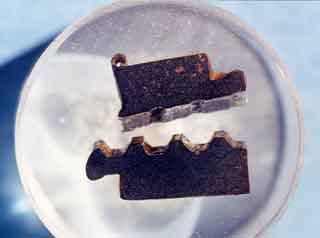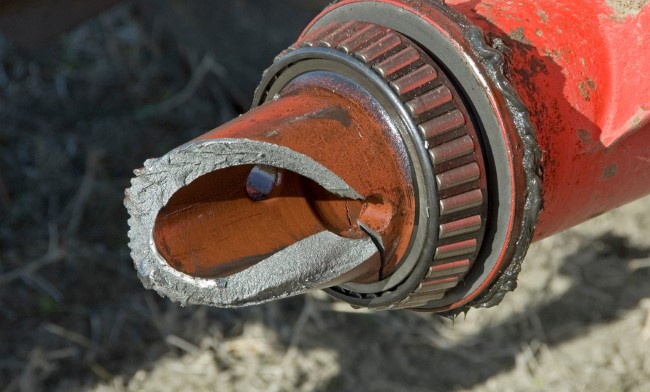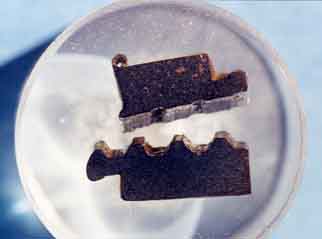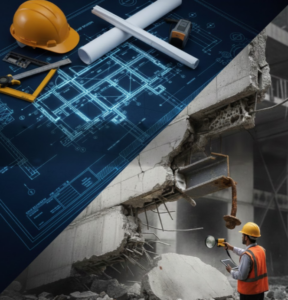When CED engineers perform an accident reconstruction, they are often faced with analyzing materials that may have been contributory or an accessory to an accident. For this reason, CED has incorporated several high tech pieces of equipment into its testing facilities to aid the investigation of materials involved in an accident. This testing can be broken down into two different parts: first, the identification of defection or material breakdown (which will be the focus of this month's issue) and second, testing for stress or strength (which will be published in the next issue).
In order to identify defects on accident material composition, CED utilizes a series of advanced microscopes and X-Ray equipment established within the scientific community. The electron microscope allows CED metallurgists to examine materials at a magnification of up to 100,000X — for such things as composition breakdown and surface cracks. Another test that is also normally completed in association with an electron microscope test is the Energy Dispersive Spectroscopy ( EDS ). The EDS works in conjunction with the electron microscope to determine the chemical composition of such materials as metals at a magnification area of a “Fly Spec”.
Another set of equipment that CED metallurgists readily use is the Optical Microscope and an industrial X-ray machine. The optical microscope allows engineers to create visual displays such as court room pictures and animation effects to show composition and magnification of the area in question. Our engineers also utilize an industrial X-Ray machine which allows the metallurgists to examine materials for stress cracks or forgery (such as a weak material covered by a stronger material). This equipment along with the scientific background and the experience of our metallurgists has allowed CED to become a powerful partner in representing cases.
CED engineers often analyze materials when they investigate and reconstruct an accident. In order to do this type of testing successfully they require a wide array of metallurgical analysis tools. The equipment utilized for testing materials can be broken into two groups. The machines for testing the strength, resistance to deformation and the composition of materials that are suspect in accident investigations are the focus for this month.
 Our Material Science Engineers can determine the composition of steel components using an Emission Spectroscope . This machine is capable of analyzing the elements contained in alloys or base metals by measuring the sparks generated by scraping the surface of the metal.
Our Material Science Engineers can determine the composition of steel components using an Emission Spectroscope . This machine is capable of analyzing the elements contained in alloys or base metals by measuring the sparks generated by scraping the surface of the metal.
To determine the composition of a non-metallic material such as plastic, CED engineers use a Fourier Transform Infrared (FT-IR) Spectrometer . This machine records the interaction of infrared radiation with a piece of material measuring the frequency and intensity of the absorbed radiation, thereby determining the material's chemical and structural characterization. FT-IR tests are classified into two categories. Qualitative testing identifies the materials and quantitative testing yields the concentration of components.
CED metallurgists utilize tensile testing machines to determine the quality and strength properties of materials such as plastics, rubber, fibers and metal. Compression and material bending tests are also performed. Polarization is used to view the stresses in material such as glass or plastic. This process is utilized by CED engineers to determine a material's resistance to deformation.
The electron microscope allows CED metallurgists to examine materials at a magnification of up to 100,000X — for such things as composition breakdown and surface cracks. Another test that is also normally completed in association with an electron microscope test is the Energy Dispersive Spectroscopy ( EDS ). The EDS works in conjunction with the electron microscope to determine the chemical composition of such materials as metals at a magnification area of a “Fly Spec”.
Another set of equipment that CED metallurgists readily use is the Optical Microscope and an industrial X-ray machine. The optical microscope allows engineers to create visual displays such as court room pictures and animation effects to show composition and magnification of the area in question. Our engineers also utilize an industrial X-Ray machine which allows the metallurgists to examine materials for stress cracks or forgery (such as a weak material covered by a stronger material). This equipment along with the scientific background and the experience of our metallurgists has allowed CED to become a powerful partner in representing cases.






